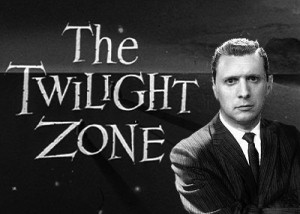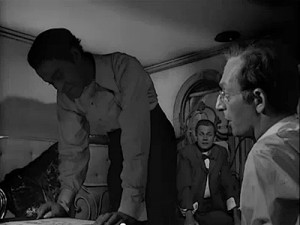Sunday, January 29th, 2012
•
Horrorthon Posts

Okay, let’s get into it. Here are my top ten (links are to Wikipedia pages, which have spoilers):
“The Four of Us Are Dying” Not especially scary (as the Zone goes) but this one has incredible mood and atmosphere (in a heavily abstracted film noir kind of style) and, like all first season episodes, has the plangent Bernard Herriman score rather than the better-known four-note-motif that came later. (You all know composer Bernard Herriman: his first movie score was Citizen Kane and his last movie score was Taxi Driver. Beat that!)
“The Hitch-Hiker” Totally terrifying. Reminiscent of the opening half-hour of Psycho (in more ways than one). Unusual in that the protagonist narrates. “Going my way?”
“Mirror Image” This one is my favorite example of a phenomenon that makes the Zone immune to modern updates (in my opinion): With the black-and-white photography, the cheap sets, and the “slice-of-life” depiction of early ‘Sixties life, Zone episodes are weird and creepy before anything happens—just the act of setting the scene (and creating what contemporary viewers experience as humdrum normalcy) can fill us modern viewers with dread. Here, it’s a lonely upstate New York bus station in the small hours of the night.
“The After Hours” See above remarks viz. 1960s normalcy. This time it’s a department store after closing time, and an elevator that goes to a floor that isn’t there…
“The Howling Man” Fucking terrifying, and possibly my favorite. Executed in a shamelessly baroque, Gothic style with frequent drunken tilted-camera angles and a protagonist/narrator who’s totally insane (or is he?)
“Twenty-Two” This one’s marred by its use of videotape (rather than film) which was a cost-cutting measure that crippled some Zone episodes, giving them an unfortunate “soap opera” vibe (which doesn’t do much to blunt the power of the idea).
“The Grave” This one’s got a wonderfully evocative “Ambrose Bierce” tonality that I totally dig. It’s that dusty, windy, moonlit Old West that only exists on film, shot on indoor sets. Lee Marvin has to prove his courage, and probably wishes he didn’t.
“The Midnight Sun” An unusually well-crafted episode, despite its limited scenario. I love this one because its closing moments (and Serling’s narration) highlight the conceptual brilliance of the series itself.
“The Dummy” A truly terrifying shocker, which stars Cliff Robertson (and is one of two Zones featuring the same spectacularly creepy “ventriloquist’s dummy” prop).
“Stopover in a Quiet Town” A little bit more whimsical, but, again, the closing twist and ending narration bring it home like nobody’s business.
Honorable Mention: “Printer’s Devil” One of the few Season 4, hour-long episodes that works (the show was unable to function properly in this longer format, in my opinion). Burgess Meredith makes my favorite of his many appearances.
I tried to focus on episodes I had a particular fondness for (or terror of). Of course I also love the following “gold standard” classics:
“Third from the Sun“
“The Eye of the Beholder“
“The Invaders“
“Will the Real Martian Please Stand Up?“
“It’s a Good Life“
“To Serve Man“
“Living Doll” (which is how we got here in the first place)
Tuesday, January 24th, 2012
•
Horrorthon Posts / Movies

Minor cinematic observation: some of the best directors have used this really great counterintuitve technique at extremely dramatic moments in their movies. The protagonist is at an absolutely critical juncture in his/her story, and (usually) is having a conversation; maybe it’s on the phone, or maybe it’s with somebody else in the room. (Or maybe it’s not a conversation; maybe it’s a monologue.) And as the man speaks, you can’t see him. You can see him all right, but his face is in shadow or obscured, or (most often) he’s turned away from the camera (maybe on the phone) and all you see is the back of his head. For example (no spoilers):
HARRISON FORD (in Witness) takes advantage of a rare trip out of the Amish community to find a pay phone and connect with his partner. He discovers some disquieting developments, makes another call, abruptly hangs up the phone…and just stands there, getting not just mad but Harrison-Ford-mad. But we can’t see his face since Peter Weir photographs the entire scene from behind his head.
JOSH BROLIN has his (only?) phone conversation with Javier Bardem (in No Country For Old Men). Same remarks. Extremely intense confrontation, but we never cut away to Bardem and we never see Brolin’s face; just the back of his head.
ROBERT DE NIRO sits and weeps in a Florida jail cell (in Raging Bull). He’s facing the camera, but his entire body is in deep shadow except for his right shoulder and arm (which shake as he cries). We can hear him whimpering but we can’t see him at all.
ORSON WELLES, as Citizen Kane, signs his “Declaration of Principles” in the New York Enquirer editorial offices. He’s leaning over the desk with a pen, talking to Bernstein and Leland. His entire upper body is silhouetted; you can’t see his face (above). (Roger Ebert pointed this one out, in his excellent feature-length commentary.)
ALAN ARKIN has a crucial conversation with an elderly resident of the coastal Italian town his unit’s based near (in Mike Nichols’ stunning Catch-22 adaptation). We’re cutting back and forth between Yossarian (Arkin) and his interlocutor, an old Italian local. In Arkin’s tight shots, he’s entirely silhouetted by the ambience from the Italian village streetlights. His head bobs (in tight focus) as he speaks, but it’s a featureless black outline.
Any others?
Saturday, January 21st, 2012
•
Tech
[So I had just finished posting the following comment on a technology website:]
Maybe I’m in the minority but I find this whole development [Apple’s new iBooks textbook technology] very disquieting.
I remember when a schoolbook or textbook was a book—an inanimate, text-based object that you, the student, had to penetrate with your own intellect and discipline.
When I was in elementary school and middle school in the 1970s there were several forays into “programmed learning” and other proto-multimedia “courses of study,” in which conventional textbooks were replaced with more interactive materials. The results were not good; the techniques were gimmicky and the teachers inevitably felt constrained by the “invisible rails” guiding their classes in pre-set patterns that were imposed by the teaching materials.
Admittedly I went to reasonably good private schools with comparatively ample budgets, but I’m sure the same principles hold true, whatever the era or the tax bracket: a teacher has to teach, creatively and forcefully, using the teaching materials as an aid or a crutch, and never as the main armature of an educational technique.
I accept that today’s students don’t ever have to look things up alphabetically or go to libraries to do basic research (and the documented, countrywide scholastic panic during this week’s Wikipedia blackout demonstrates why), but can’t students be expected to deal with a conventional textbook, and all the challenges it presents? Shouldn’t a student have to come to grips with Euclidean geometry by reading paragraphs and looking at line drawings (rather than watching animations)? Shouldn’t a student be required to read fifteen or twenty consecutive paragraphs about (say) the Louisiana Purchase or the Peloponnesian War, rather than simply seeing video clips, animated maps and nonlinear sidebar explanations?
We’re living in a century in which nobody has to know how to spell, how to find a restaurant, how to get oriented when lost, how to translate simple phrases into other languages (or make metric conversions or perform simple arithmetic). Should students really be deprived of what will, for many, be their one opportunity in life to at least attempt to think for themselves?
Obviously Apple’s new technology is both economically liberating (for those who need to buy textbooks) and potentially improves the conventional “textbook” model (since obsolete materials can be replaced instantly). But can’t all those iPad screens be primarily exposing students to real books and not interactive multimedia programs?
[And then right after posting the above, I saw this headline:]
Student math scores jump 20% with Apple iPad; transforms classroom education

